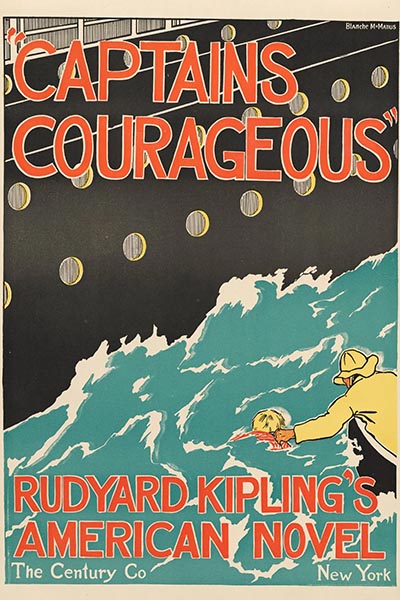
Poster Child
Did you know that the publishing world used to advertise books and periodicals using posters? It was not a marketing strategy that lasted for very long—the “literary poster” craze kicked off in 1893 and lasted only about a decade. And now, a new book and museum exhibition pays tribute to this long-forgotten mix of advertising and fine art. Says The New York Times:
Images like these, as Allison Rudnick writes in her introduction to “The Art of the Literary Poster” (Metropolitan Museum of Art/Yale University Press, $50), “epitomized the vanguard in graphic design.” (Rudnick is an associate curator at the Met, where an exhibit featuring dozens of these artifacts runs through June 11). They also provided a rare platform for gifted female illustrators of the era like Florence Lundborg and Ethel Reed — even if those efforts were often damned with faint, feminizing praise in contrast to the output of their male counterparts.

So much for CMYK:
Success in the field could indeed be arbitrary; an entry by a young Maxfield Parrish in a contest sponsored by a now-defunct monthly called The Century allegedly earned him only second prize because his submission required four colors rather than three to produce. Even in monochrome, though, these works would still dazzle: artifacts of a vanished world in which ads were objects of beauty, and reading — even on two wheels — was indelibly, indubitably chic.
Exploding Market
Here’s a packaging niche that sees explosive growth, but not in the way we think: fireworks packaging. Via Boing Boing, a new zine called Incendiary: Volume 1 by Jonah Bergman looks at the art of fireworks packaging design.
The cute fireworks cartoon characters, as well as the funny and provocative titles, are not typically encountered in a curated art context. By presenting these images in a zine, it combines a sense of fun and danger in a potential narrative format, one that sparks curiosity about the explosives’ history and the experiences they created for the people who blew them up.

That’s cute?
It's published by desiredfx, an independent DIY publishing label of L. Coats. The striking covers and layout of the zine were also designed by Coats. If you’re interested in purchasing one of the limited copies, send them a message on Instagram.
Bright Ideas
Quick: name a technology that transformed the world. Printing press, certainly. Computer, yep. Sliced bread…well, maybe not so much. But one of the most game-changing introductions in the history of civilization is something we don’t even think about: affordable artificial light. Says Big Think:
We have forgotten how unrelentingly dark the pre-industrial world was. Switch on a nightstand lamp or kitchen light, and you instantly and effortlessly summon into existence more illumination than was available to entire pre-industrial households. Artificial light has historically been the expensive privilege of the wealthy and powerful, while simultaneously being laborious and dirty to produce and maintain, and extremely limited in availability and quality for nearly everyone — but most especially for the world’s poor, which until industrialization was basically everyone.
It was also expensive.
It is difficult to fathom just how expensive light was in the pre-industrial world. In what is now the United Kingdom, the price, adjusted for inflation, per million-lumen hours of artificial light was >£40,000 (or roughly $50,000 USD) in 1302 CE. This is the cost-to-light output equivalent to running ten modern 13W LED bulbs for just 7 hours.
Candles were a pricey commodity, but it wasn’t until the 19th century that an alternative was found—and even it was not cheap.
Whale oil provided the first scalable, bright, reliable, adjustable, and portable on-demand artificial light. Whale oil burned with a clean and steady light and could be moved from room to room by lamp or illuminate a book held in the lap, presuming you could afford a book. Despite an initial abundance of whales, whale oil was expensive to harvest, refine, and transport. While whale oil provided the best illumination during the early Industrial Revolution, it was still astonishingly expensive. In 1850, four liters of whale oil cost as much as half the weekly wage of an average worker.
And it was no fun for the whales. Gas lighting (not to be confused with gaslighting) came next, but was not without its problems.
Gas lighting was available sporadically in Europe and America in the early 1800s; however, gas lighting was expensive to install and maintain, relatively dangerous, and produced toxic vapors that killed plants, nauseated people, and destroyed fabrics. The wealthy who could afford gas often disdained it, and the poor couldn’t afford it. The niche for gas was largely commercial and industrial…
And it was a few years before the breakthrough technology was discovered: kerosene.
Kerosene was a genuine breakthrough in lighting technology — it burnt brilliantly and could be produced cheaper than any illuminant that came before it: no whale massacres required. Kerosene squeezed from coal helped to drive the cost of light dramatically and, when paired with new lamp technology, provided a bright, odor-free, non-perishable, and inexpensive flame, all features that were not an innate property of whale oil.
The original source of kerosene—coal tar—was not scalable, but once it could be refined from crude oil, we were off to the races. (This would also not be without its consequnces.)
The first lighting revolution fueled by kerosene illuminated factories, workshops, and businesses and, in doing so, dramatically transformed the productivity of our species at night. Millions of middle-class and poor families had their first real opportunity to enjoy relatively clean, safe, bright, portable artificial lighting within the home.
Then came electrification.
The innovation trajectory that began with the first commercially available incandescent lighting has made clean, safe, and inexpensive artificial light available to nearly all of humanity and in doing so, has transformed civilization.
Face Palm
Ah, now here’s our kind of social media platform: one that doesn’t actually exist. Meet Palmsy, a “fake” social media platform that gives you all the dopamine highs of getting “likes” without the trolls and flame wars. Says Gizmodo:
However, the likes on Palmsy aren’t the only thing that’s fake. Although it looks like a social media app, it’s hard to call it that when you’re essentially talking and interacting with yourself. You can post on Palmsy, but those posts don’t go out to anyone, just as god intended. When it comes to the likes, the app simply sends you notifications by pulling random names from your phone’s contact list. Those people haven’t really liked your post, though. They’ve never even seen it.
Mock it if you will, and you know we will, but it does have some therapeutic value, in that it gives you a safe space to post dumb stuff that you’d never share with your network and get it off your chest. (Would that more people used it.)

Palmsy’s developer, Pat Nakajima, probably summed it best in a post on Threads: “is it useful? No not as such. Is it fun? Kinda? Is it free? Hell yea it is.”
We may check it out, and only report on it via Palmsy.
Graphene Gets Anti-Inflammatory
Was it a good week for graphene news? It’s always a good week for graphene news! Graphene-based cell cultures may be poised to help MS patients. From (who else?) Graphene-Info:
A team from the National Hospital for Paraplegics (SESCAM), in collaboration with the Materials Science Institute of Madrid (ICMM-CSIC), has shown how new cell culture devices based on graphene oxide maintain the anti-inflammatory function of myeloid suppressor cells (MDSCs) once isolated from the donor's body. This function could be crucial for advancing cellular therapy beneficial to people with multiple sclerosis.
… In recent years, nanomedicine has emerged as a revolutionary field for developing novel medical applications. Among the most relevant nanomaterials being investigated for biomedical applications, graphene derivatives are becoming promising candidates for both diagnostic and therapeutic uses.
Wear Well
It’s a fairly safe bet that the smartphone as we know it is very much a transitional technology, with the future of computing and interacting with the world some kind of wearable technology. And “wearable AI” might be just around the corner. Says The Guardian:
Imagine it: you’re on the bus or walking in the park, when you remember some important task has slipped your mind. You were meant to send an email, catch up on a meeting, or arrange to grab lunch with a friend. Without missing a beat, you simply say aloud what you’ve forgotten and the small device that’s pinned to your chest, or resting on the bridge of your nose, sends the message, summarises the meeting, or pings your buddy a lunch invitation. The work has been taken care of, without you ever having to prod the screen of your smartphone.
California startup Humane is thus launching the Ai Pin, a small device that attaches to your shirt via a magnet. It sends texts, makes calls, takes pictures, and plays music.
But it doesn’t support apps or have a screen. Instead, it uses a laser to project a simple interface on to your outstretched palm, and its inbuilt AI chatbot can be instructed through voice commands to search the web or answer queries in much the same way you would expect of ChatGPT.

It’s not a big leap to the Star Trek badge-based communicators.
“I am planning to train Ai Pin to be my personal assistant and facilitate my writing and creative work,” says Virginia-based consultant Tiffany Jana, who’s pre-ordered the device before its initial US launch in April (Humane hasn’t yet announced a full global release schedule). She travels frequently and hopes it will be able to take the place of an accompanying photographer and translator. “I don’t have all the assistants and the massive team that once supported me. I’ve always been a technophile and I enjoy ChatGPT.”
Hmm…translate. How is it with German?
If all of this sounds remarkably similar to what the voice assistant on your smartphone or the Alexa in your living room is already capable of, that’s because it essentially is. “Using AI in new devices is standard even nowadays,” says David Lindlbauer, assistant professor at the Human-Computer Interaction Institute at Carnegie Mellon University in Pennsylvania. “Everyone uses Google’s suggestions, Apple Siri for interacting with their phone, or smart suggestions for apps on their phones.” The difference, he says, is that these new and forthcoming devices try to embed their AI capabilities in “a less obtrusive and more ubiquitous manner”.
UPDATE: Alas, it doesn’t work.
ANYmal Magnetism
ANYmal is a four-legged dog-like robot developed by researchers at ETH in Zürich, Switzerland. The goal is to ultimately using these robots for search-and-rescue operations. Now, ANYmal has been upgraded to perform basic parkour moves. Says Ars Technica:
Human parkour enthusiasts are known for their remarkably agile, acrobatic feats, and while ANYmal can't match those, the robot successfully jumped across gaps, climbed up and down large obstacles, and crouched low to maneuver under an obstacle, according to a recent paper published in the journal Science Robotics.
…As advanced as ANYmal and similar-legged robots have become in recent years, significant challenges still remain before they are as nimble and agile as humans and other animals.
Well, some humans….
“Before the project started, several of my researcher colleagues thought that legged robots had already reached the limits of their development potential,” said co-author Nikita Rudin, a graduate student at ETH Zurich who also does parkour. “But I had a different opinion. In fact, I was sure that a lot more could be done with the mechanics of legged robots.”
Strong Suits
We hate to nick someone else’s headline, but, “well, jet suit racing is now a thing.” From Core77:
The last time we looked in on jet suit company Gravity Industries, the UK’s Royal Marines were using their jet suits to board a ship. More recently the company made the news for a non-military happening: They’ve held their inaugural Jet Suit Race in Dubai, hoping to generate some F1-levels of excitement.
As you would expect, the race is held over water for safety reasons.
Each competitor wears seven pieces of jet-thrust-providing Gravity Industries kit--two jets on each arm, three on their back--that cumulatively put out over 1,000 horsepower. While there is no wall for the racers to crash into, the real danger is of colliding with a fellow racer who’s also wearing a 75-pound suit and a five-gallon gasoline tank.

It does look fun…
Thereby Hangs a Tail
As we move further and further into space, there is one thing we are going to need, apparently: a tail. Huh? Industrial design student Cheng Chang is prepared.
“In the plausible future, there is going to be a whole generation of humans living their lives in zero-gravity,” Chang writes. “This kind of environmental shift will totally reshape our understanding of space and body function.”
Grant the premise? OK… The Augmented Limb for Zero-Gravity Movement Control is a stabilizing tail for floating astronauts that can anchor them to their surroundings and/or stabilize their position whilst floating inside a space station.

And you can also wag it to let the other astronauts know you’re happy to see them.
Super Nova
Hopefully you managed to catch the eclipse on Monday. Syracuse, N.Y., was unsurprisingly cloudy:

If you were not in the path of totality, there is another upcoming celestial event (there’s always something going on up there) that will be visible to the naked eye: a star going nova. The star in question is T Coronae Borealis, and it explodes approximately every 80 years. Says The Guardian:
The star, T Coronae Borealis, is actually composed of two stars: a red giant and a white dwarf. The white dwarf is a dense stellar core about the size of the Earth and its gravity is pulling gas off the red giant. This gas accumulates on the white dwarf’s surface before detonating in a thermonuclear explosion, causing the star to temporarily brighten. Eventually, it returns to normal and the cycle repeats.
It is located in the constellation Coronae Borealis in the Northern Celestial Hemisphere. Scientists expect it to explode sometime between April and September 2024. So keep watching the skies!
Axes: Bold As Love
One of the consequences of the punk revolution of the 1970s was that bands stopped putting a premium on musicianship. (Back the day, the major rock magazines used to have readers vote for Best Guitarist, Best Bassist, Best Drummer, etc. Who would win these awards these days?) The trend only continued. Another consequence is that you don’t hear guitar solos all that much anymore. Via Laughing Squid, essayist Noah Lefevre of Polyphonic looks at the music of the 1990s and 2000s and tracks the decline of the once-ubiquitous guitar solo.
The grunge scene that erupted out of Seattle in the early 90s in response to the indulgences of hard rock began an era of guitar decline but the guitarists responsible had no intention of killing their own art form.
To Dye For
Given the publication date of this article, you’d be forgiven for thinking it was a prank, but, no, apparently it’s a real thing: Velveeta Hair Dye. Says Food & Wine:
On Monday, the company best known for its brightly colored cheese announced it is getting into the personal care game with Velveeta Gold, its very first hair dye. And it promised Food & Wine — over and over again — that it indeed isn't a joke.
OK, we like the name:
“La Dolce Velveeta is a lifestyle — always confident and forever in service of living by your own rules,” Stephanie Vance, brand manager for Velveeta, shared in a statement about the new product. “We are always looking for new ways to help fans live La Dolce Velveeta, and hair was the perfect place for us to invite pleasure seekers to proudly express themselves and show off their unique style and individuality.”

It’s “semi-permanent” and available only on Amazon in a four-ounce jar, which Velveeta says is “enough to cover a head of short hair.” (“Semi-permanent”? Is that like “semi-boneless” or “slightly pregnant”?) “All users need to do is apply it evenly to dry hair and allow it to process for 20 minutes before rinsing it with a mild shampoo and water.” What, you don’t have to microwave your head? A steal at $7.50, “which happens to also be the price of a Velveeta cheese loaf and is only available for a limited time.”
This Week in Printing, Publishing, and Media History
May 8
1880: French novelist Gustave Flaubert dies (b. 1821).
1886: Pharmacist John Pemberton first sells a carbonated beverage named “Coca-Cola” as a patent medicine.
1912: Paramount Pictures is founded.
1920: American graphic designer and director Saul Bass born.
1926: English environmentalist and television host David Attenborough born.
1926: American comedian and actor Don Rickles born.
1937: American novelist Thomas Pynchon born.
1980: The World Health Organization confirms the eradication of smallpox. (Well, for now, anyway...)
1984: American publisher, co-founder of Reader’s Digest Lila Bell Wallace dies (b. 1890).
1985: American author and critic Theodore Sturgeon dies (b. 1918).
1988: American science fiction writer and screenwriter Robert A. Heinlein dies (b. 1907).
May 9
1911: The works of Gabriele D’Annunzio are placed in the Index of Forbidden Books by the Vatican.
1958: Alfred Hitchcock’s film Vertigo has world premiere in San Francisco.
May 10
1824: The National Gallery in London opens to the public.
1869: The First Transcontinental Railroad, linking the eastern and western United States, is completed at Promontory Summit, Utah with the golden spike.
1902: American director and producer David O. Selznick born.
1954: Bill Haley & His Comets release “Rock Around the Clock,” the first rock and roll record to reach number one on the Billboard charts.
1962: Marvel Comics publishes the first issue of The Incredible Hulk.
1975: Sony introduces the Betamax videocassette recorder in Japan.
May 11
868: A copy of the Diamond Sutra is printed in China, making it the oldest known dated printed book.
1811: Thai-American conjoined twins Chang and Eng Bunker born.
1854: German-American engineer, invented the Linotype machine Ottmar Mergenthaler born.
1904: Spanish painter and illustrator Salvador Dalí born. (Fish.)
1942: William Faulkner's collections of short stories, Go Down, Moses, is published.
2001: English novelist and screenwriter Douglas Adams dies (b. 1952). So long, and thanks for all the fish.
May 12
1593: London playwright Thomas Kyd is arrested and tortured by the Privy Council for libel.
1812: English poet and illustrator Edward Lear born.
1828: English poet and painter Dante Gabriel Rossetti born.
1846: The Donner Party of pioneers departs Independence, Mo., for California, on what will become a year-long journey of hardship and cannibalism.
1937: American comedian, actor, and author George Carlin born.
1941: Konrad Zuse presents the Z3, the world's first working programmable, fully automatic computer, in Berlin.
May 13
1842: English composer Arthur Sullivan born.
1907: English novelist and playwright Daphne du Maurier born.
1922: German graphic designer and typographer Otl Aicher born.
1937: American author and poet Roger Zelazny born.
1944: American author, screenwriter, and actor Armistead Maupin born.
1954: The original Broadway production of The Pajama Game opens and runs for another 1,063 performances. It will later receive three Tony Awards for Best Musical, Best Performance by a Featured Actress in a Musical, and Best Choreography.
May 14
1925: Virginia Woolf’s novel Mrs Dalloway is published.
1944: George Lucas born. (May the 14th be with you....)
1952: Singer-songwriter, producer, and actor David Byrne born.
1993: American journalist and publisher William Randolph Hearst, Jr. dies (b. 1908).















Discussion
Only verified members can comment.